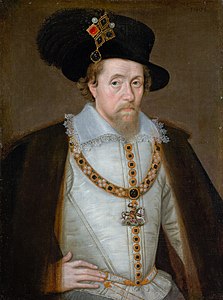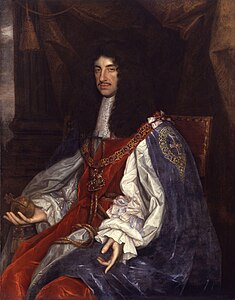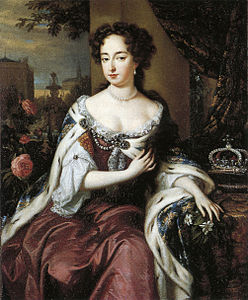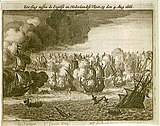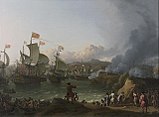Stuart period
| Stuart era | |||
|---|---|---|---|
| 1603–1714 | |||
 King Charles I and the soldiers of the English Civil War as illustrated in An Island Story: A Child's History of England (1906) | |||
| Including |
| ||
| Monarch(s) |
| ||
| Leader(s) | |||
Chronology
| |||
| History of England |
|---|
 |
|
|
| Periods in English history |
|---|
| Timeline |
The Stuart period of British history lasted from 1603 to 1714 during the dynasty of the House of Stuart. The period ended with the death of Queen Anne and the accession of King George I from the German House of Hanover.
The period was plagued by internal and religious strife, and a large-scale civil war which resulted in the
Political history
James VI and I: 1603–1626
Rule of the upper-classes
England was ruled at the national level by royalty and nobility, and at the local level by the lesser nobility and the gentry. Together they comprised about 2% of the families, owned most of the good farmland, and controlled local government affairs.
Three kingdoms
James VI, king of Scotland, also became king of the entirely separate kingdom of England when
Charles I: 1625–1649
King James was failing in physical and mental strength, because of this he was often mocked by his family and his own father would throw objects at him when he would try to stand up, and decision-making was increasingly in the hands of Charles and especially George Villiers (1592–1628), (he was Earl of Buckingham from 1617 and Duke from 1623). Buckingham showed a very high degree of energy and application, as well as a huge appetite for rewards and riches. By 1624 he was effectively the ruler of England. In 1625 Charles became the king of a land deeply involved in a European war and rent by escalating religious controversies. Buckingham and Charles developed a foreign policy based on an alliance with France against Spain. Major foreign adventures against Cádiz in 1625 and in support of French Huguenots in 1627 were total disasters. Widespread rumour shaped public opinion that blamed Buckingham, rather than the king, for the ills that beset England. When Parliament twice opened impeachment proceedings, the king simply prorogued (suspended) the Parliament. Buckingham was assassinated in 1628 by John Felton, a dissatisfied Army officer. The assassin was executed, but he nevertheless became a heroic martyr across the three kingdoms.[9] Like his father, King Charles believed in the divine right of kings to rule, and he was unable to work successfully with Parliament. By 1628 he and Buckingham had transformed the political landscape. In 1629 the king dissolved parliament and began a period of eleven years of personal rule.[10][11]
Personal rule: 1629–1640
English government was quite small, for the king had no standing army, and no bureaucracy stationed around the country. Laws were enforced primarily by local officials controlled by the local elites. Military operations were typically handled by hired mercenaries. The greatest challenge King Charles faced in ruling without a parliament was raising money. The crown was in debt nearly £1.2 million; financiers in the City refused new loans.
Long Parliament of 1640
Revolts broke out in Scotland in response to the king's imposition of the
Civil War and Interregnum: 1642–1660

The
The monarchy was temporarily displaced by the Commonwealth of England from 1649 to 1660. Oliver Cromwell ruled directly from 1653 to his death in 1658, whereupon his Commonwealth disintegrated. The Convention Parliament welcomed Charles II, son of Charles I, to return from exile and become king.
The war period (1642–1651) saw a series of armed conflicts and political machinations between Parliamentarians and Royalists, with most of the fighting in England. The
The overall outcome was threefold:
Cromwell
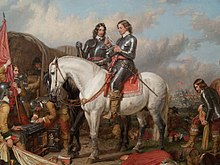
In 1649–59 the dominant figure in England—although he refused the offer of kingship—was Oliver Cromwell, the highly successful Parliamentarian general.[22] He worked hard at the time to ensure good publicity for his reign, and his successful wars. He remains a favourite topic of historians even as he is one of the most controversial figures in British history and his intense religiosity has long been out of fashion.[23]
The Commonwealth: 1649–1653
After the execution of the King, a republic was declared, known as the
The Protectorate: 1653–1658
In December 1653 Cromwell was appointed Lord Protector, with powers akin to those of a monarch. Cromwell's power was buttressed by his continuing popularity among the army, which he had built up during the civil wars, and which he subsequently prudently guarded, and during his period of dictatorship he divided England into military districts ruled by Army Major Generals who answered only to him. The 15 major generals and deputy major generals—called "godly governors"—were central to Cromwell's moral crusade beginning in October 1655. They lasted less than a year. The generals not only supervised militia forces and security commissions, but collected taxes and insured support for the government in the English and Welsh provinces. They were resented by provincials. Many members of Parliament feared the generals threatened their reform efforts and authority. Their position was further harmed by a tax proposal by Major General John Desborough to provide financial backing for their work, which Parliament voted down for fear of a permanent military state. Ultimately, however, Cromwell's failure to support his men, sacrificing them to his opponents, caused their demise.[27]
The
Cromwell was aware of the contribution that Jewish financiers made to the economic success of Holland, now England's leading commercial rival. It was this that led to his encouraging Jews to return to England, 350 years after their banishment, in the hope that they would help speed up the recovery of the country after the disruption of the Civil Wars.[28]
In 1657, Cromwell was offered the crown by a re-constituted Parliament; since he had been instrumental in abolishing the monarchy he said no after long deliberation. He ruled as king in all but name, but his office was not hereditary. Instead Cromwell was to nominate his own successor. Cromwell's new rights and powers were laid out in the Humble Petition and Advice, a legislative instrument which replaced the 1653 Instrument of Government.
Historiography
The older
In the post-war era (1945–), the class conflict of the Marxist interpretation emerged as a powerful explanation that seemed to tie all the details together. It portrayed a battle between the declining Crown and upper class feudalistic aristocracy, versus the rising middle class gentry. Marxists downplayed the religious dimension. On one side, influential names included R. H. Tawney, Lawrence Stone, and the Marxist Christopher Hill. The main argument was that the Civil War was a challenge launched by the rising gentry class to overcome the power of the Crown and the aristocracy. Marxists like Hill saw the war as England's bourgeois revolution—that is, the overthrow of an outdated feudal order by the new middle class. The class conflict interpretation was vigorously challenged by conservative scholars, such as Hugh Trevor-Roper, who argued that the gentry was not rising but instead felt that its status was being undermined. It fought back against its exclusion from the power, patronage and payoff by an extravagant court, by the king's swelling state bureaucracy and by the nouveau riche financiers in London.[30][31][32]
Marxist historiography itself lost much of its intellectual support after the 1960s. "Revisionists" came to the fore, rejecting both Whig and Marxist approaches because they assumed historical events were the automatic playing out of mysterious forces such as "liberty"and "class conflict."[33] New microscopic local studies demonstrated that the class differences between the two sides varied greatly from place to place, and did not explain very much.[34] Once The revisionists had dispatched the older models, the "post-revisionists" began to offer a multiplicity of small-scale explanations that fitted particular localities. Historians now give much more emphasis to religiosity, and to the diversity of local situations. Instead of an argument that massive popular anger had built up in the early 17th century and caused the Civil War, the current approaches depict the early Stuart period as marked by harmony, good government, and popular support. How then could there be a civil war? The current scholarly solution is to emphasise what historians call the "British problem", involving the impossible tensions occurring when a single person tried to hold together his three kingdoms with their entirely different geographical, ethnic, political, and religious values and traditions.[35][36]
Restoration and Charles II: 1660–1685

Widespread dissatisfaction with the lack of the king led to the Restoration in 1660, which was based on strong support for inviting Charles II to take the throne.[37] The restoration settlement of 1660 reestablished the monarchy, and incorporated the lessons learned in the previous half century. The first basic lesson was that the king and the parliament were both needed, for troubles cumulated when the king attempted to rule alone (1629–1640), when Parliament ruled without a king (1642–1653) or when there was a military dictator (1653–1660). The Tory perspective involved a greater respect for the king, and for the Church of England. The Whig perspective involved a greater respect for Parliament. The two perspectives eventually coalesced into opposing political factions throughout the 18th century. The second lesson was that the highly moralistic Puritans were too inclined to divisiveness and political extremes. The Puritans and indeed all Protestants who did not closely adhere to the Church of England, were put under political and social penalties that lasted until the early 19th century. Even more severe restrictions were imposed on Catholics and Unitarians. The third lesson was that England needed protection against organised political violence. Politicized mobs in London, or popular revolts in the rural areas, were too unpredictable and too dangerous to be tolerated.[38][39] The king's solution was a standing army, a professional force controlled by the king. This solution became highly controversial.[40]
The Restoration of 1660 was a deliberate return to the stability of the early 17th century. There was very little recrimination. King Charles acted with moderation and self-restraint, and with energy and attention to details.
The King and Parliament agreed on a general pardon, the Indemnity and Oblivion Act (1660). It covered everyone, with the exception of three dozen regicides who were tracked down for punishment. The terms of the settlement included giving the King a fixed annual payment of £1.2 million; Scotland and Ireland added small additional amounts. It was illegal to use dubious non-parliamentary fund-raising such as payments for knighthood, forced loans, and especially the much-hated ship money. Parliament did impose an entirely new excise tax on alcoholic beverages that raise substantial sums, as did the customs, for foreign trade was flourishing. Parliament closed down the harsh special courts that Charles had used before 1642, such as the Star Chamber, Court of High Commission, and the Council of the North. Parliament watched Charles' ministers closely for any signs of defiance, and was ready to use the impeachment procedure to remove offenders and even to pass bills of attainder to execute them without a trial.[44]
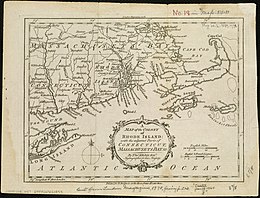
Religious issues proved the most difficult to resolve. Charles reinstated the bishops, but also tried to reach out to the Presbyterians. Catholics were entirely shut out of opportunities to practice their religion or connect to the Papal States in Rome. The Royalists won a sweeping election victory in 1661; only 60 Presbyterians survived in Parliament. Severe restrictions were now imposed on the Nonconformist Protestant bodies in England, preventing them from holding scheduled church services, and prohibiting their members from holding government offices at the national or local level. For example, The five-mile law in 1665 made it a crime for nonconformist clergymen to be within 5 miles of their old parish.[46] The Puritans still controlled the Massachusetts Bay Colony and the Connecticut Colony, but they kept a low profile during the interregnum. Charles II cancelled their charters and imposed centralised rule through the Dominion of New England. His colonial policies were reversed by William III. Most of the smaller independent religious factions faded away, except for the Quakers. The Congregationalists, Presbyterians, and Baptists remain, and were later joined by the Methodists. These non-Anglican Protestants continued as a political factor, with its leaders moving toward what became the Whig party. The country gentry continued to form the basis of support for the Church of England, and for what became the Tory party.[47]
Parliament was especially alarmed at the success of Cromwell's New Model Army, which demonstrated that a well-organized, well-led professional army was far superior to poorly trained militia units. Cromwell had used his standing army to take full personal control, and so it was much to be feared as a threat to traditional liberties. The New Model Army was permanently disbanded, and all the soldiers received their full back pay. On the other hand, as long as enemy nations such as Spain and France, had large standing armies, England was practically defenceless on land. King and Parliament all agreed on the wisdom of a strong expanded Royal Navy. But while the king tried to build up a small standing army, Parliament kept a very close, nervous watch.[48]
Puritanism was entirely out of fashion, as the royal court introduced a level of
Standing army
England never had a standing army with professional officers and careerist corporals and sergeants. It relied on militia organised by local officials, private forces mobilised by the nobility, or on hired mercenaries from Europe.[50] Cromwell changed all that with his New Model Army of 50,000 men, that proved vastly more effective than untrained militia, and enabled him to exert a powerful control at the local level over all of England. At the restoration, Parliament paid off Cromwell's army and disbanded it. For many decades the Cromwellian model was a horror story and the Whig element recoiled from allowing a standing army.[51] The militia acts of 1661 and 1662 prevented local authorities from calling up militia and oppressing their own local opponents. Calling up the militia was possible only if the king and local elites agreed to do so. However, King Charles managed to pull together four regiments of infantry and cavalry, calling them his guards, at a cost of £122.000 from his general budget. This became the foundation of the permanent British Army, By 1685 it had grown to 7500 soldiers in marching regiments, and 1400 men permanently stationed in garrisons. A rebellion in 1685 allowed James II to raise the forces to 20,000 men. There were 37,000 in 1678, when England played a role in the closing stage of the Franco-Dutch War. In 1689, William III expanded the army to 74,000 soldiers, and then to 94,000 in 1694. Parliament became very nervous, and reduced the cadre to 7,000 in 1697. Scotland and Ireland had theoretically separate military establishments, but they were unofficially merged with the English force.[52]
Glorious Revolution of 1688–1689
The British have always regarded the overthrow of King James II of England in 1688 as a decisive break in history, especially as it made the Parliament of England supreme over the King and guaranteed a bill of legal rights to everyone. Steven Pincus argues that this revolution was the first modern revolution; it was violent, popular, and divisive. He rejects older theories to the effect that it was an aristocratic coup or a Dutch invasion. Instead, Pincus argues it was a widely supported and decisive rejection of James II. The people could not tolerate James any longer. He was too close to the French throne; he was too Roman Catholic; and they distrusted his absolutist modernisation of the state. What they got instead was the vision of William of Orange, shared by most leading Englishmen, that emphasised consent of all the elites, religious toleration of all Protestant sects, free debate in Parliament and aggressive promotion of commerce. Pincus sees a dramatic transformation that reshaped religion, political economy, foreign policy and even the nature of the English state.[53][54]
William and Mary: 1688–1702
During the joint rule of William and Mary, William made the decisions when he was in Britain; Mary was in charge when he was out of the country and also handled Church affairs. William encouraged the passage of major laws that protected personal liberties.
Foreign policy

The primary reason the English elite called on
Legacy of William III
Historian Stephen B. Baxter is a leading specialist on William III, and like nearly all his biographers he has a highly favourable opinion of the king:
- William III was the Deliverer of England from the tyranny and arbitrary government of the Stuarts....He repaired and improved an obsolete system of government, and left it strong enough to withstand the stresses of the next century virtually unchanged. The army of Marlborough, and that of Wellington, and to a large extent that of Raglan, was the creation of William III. So too was the independence of the judiciary..... [His government] was very expensive; at their peak the annual expenditures of William III were four times as large as those of James II. This new scale of government was bitterly unpopular. But the new taxes, which were not in fact heavy by comparison with those borne by the Dutch, made England a great power. And they contributed to the prosperity of the country while they contributed to its strength, by the process which is now called 'pump-priming.'[70]
Queen Anne: 1702–1714

Anne became queen in 1702 at age 37, succeeding William III whom she hated.
Anne took a lively interest in affairs of state, and was a noted patroness of theatre, poetry and music. She subsidised George Frideric Handel with £200 a year.[76] She began the practice of awarding high-quality gold medals as rewards for outstanding political or military achievements. They were produced at the Mint by Isaac Newton and engraver John Croker.[77]
Union with Scotland in 1707
Scotland and England were entirely separate countries, having the same ruler since 1603. Queen Anne, ruling both countries, worked to bring them together in the Acts of Union 1707. Public opinion in Scotland was generally hostile, but elite opinion was supportive, especially after the English provided generous financial terms and timely bribes. The Parliament of Scotland agreed to the terms and disbanded. The new Parliament of Great Britain was in practice simply the old Parliament of England augmented by 45 Scots elected to Commons; it selected 16 Scottish peers for the House of Lords. Scotland was much smaller in terms of population and wealth. Its colonial venture in the Darien scheme had been a major financial and humanitarian disaster. The Acts of Union refunded the losses of the Scottish investors in Darien. In basic terms, Scotland retained its own Presbyterian established church, and its own legal and educational systems, as well it is its own separate nobility. The Scots now paid English taxes, although in reduced rates, and had a voice in the affairs of Great Britain.[78][79]
The long-term economic benefits took a couple of generations to be realised, and long-standing distrust continued for generations. The risk of war between the two was greatly diminished, although Jacobite raids launched from the north hit England for another forty years. The new Britain used its power to undermine the clanship system in the Scottish Highlands[80] Ambitious Scots now had major career opportunities in the fast-growing overseas British colonies, and in the rapidly growing industrial and financial communities of England. Scotland benefited, says historian G.N. Clark, gaining "freedom of trade with England and the colonies" as well as "a great expansion of markets." Clark argued that in exchange for the financial benefits and bribes that England bestowed, what it gained was:
- of inestimable value. Scotland accepted the Hanoverian succession and gave up her power of threatening England's military security and complicating her commercial relations ... The sweeping successes of the eighteenth-century wars owed much to the new unity of the two nations.[81]
By the time Samuel Johnson and James Boswell made their tour in 1773, recorded in A Journey to the Western Islands of Scotland, Johnson noted that Scotland was "a nation of which the commerce is hourly extending, and the wealth increasing" and in particular that Glasgow had become one of the greatest cities of Britain.[82]
Social and economic history
Population
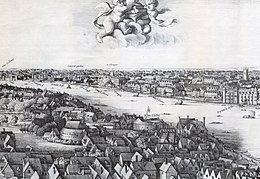
The total population of England grew steadily in the 17th century, from 1600 to about 1660, then declined slightly and stagnated between 1649 and 1714. The population was about 4.2 million in 1603, 5.2 million in 1649, 5.1 million in 1660, 4.9 million in 1688, and 5.3 million in 1714.[83][84] By 1714 the Greater London area held about 674,000 people, or one in nine of England's population. The next cities in size were Norwich and Bristol (with a population of about 30,000 each). About 90% of the people lived in rural areas in 1500, compared to 80% of a much larger population in 1750.[85]
Witchcraft and magic
Historians have recently placed stress on how people at the time dealt with the supernatural, not just in formal religious practice and theology, but in everyday life through
The government made witchcraft a capital crime under Queen
Historian Peter Homer has emphasised the political basis of the witchcraft issue in the 17th century, with the Puritans taking the lead in rooting out the Devil's work in their attempt to depaganise England and build a godly community. As the process of psychological modernisation reached more and more people, fears of witchcraft and magic tended to steadily diminish. After 1660 Puritans were largely excluded from the judiciary and lost their power to investigate. In 1712, Jane Wenham was the last woman found guilty of witchcraft in England. In 1735 Parliament no longer believed that witchcraft was real—despite the efforts of James Erskine, Lord Grange, the Scottish Lord who made a fool of himself speaking in opposition. Parliament passed the Witchcraft Act 1735 which made it a crime to accuse someone of witchcraft. The laws against witchcraft were not fully repealed until 1951 with the passing of the Fraudulent Mediums Act 1951.[91] Witchcraft was a minor issue of little importance in Ireland.[92] However, Scotland was a major centre of suppression; 3900 Scots were tried; two thirds were convicted and executed, the last of whom was Janet Horne in 1727.[93]
Education
There was no free schooling for ordinary children, but in the towns and cities small local private schools were opened for the benefit of the boys of the middle classes, and a few were opened for girls. The rich and the nobility relied on private tutors. Private schools were starting to open for young men of the upper classes, and universities operated in Scotland and England. The University of Oxford and the University of Cambridge provided some education for prospective Anglican ministers, but otherwise had academic standards well below their counterparts in Scotland.[94][95]
Historians have looked at local documents to see how many men and women used their signature and how many used X's. Literacy rates were very low before 1500, but grew steadily in the next three centuries, with men twice as likely to be literate as comparable women. In 1500, literacy rates for women were 1%; by 1560 they had reached 5%; by 1640 about 10%; by 1710 about 25% (versus 50% for men). Two forces were at work: Protestant religion called for the ability to read the Bible, and changing social and economic conditions. For example, towns grew rapidly, providing jobs in retailing in which literacy was a distinct advantage.[96][97]
Popular culture
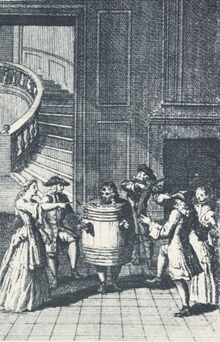
When the Puritans fell out of power, the tight social norms gave way to more liberal pleasures.[98] The theatres returned, and played a major role in high society in London, where they were patronised by royalty. Historian George Clark argues:
- The best-known fact about the Restoration drama is that it is immoral. The dramatists did not criticise the accepted morality about gambling, drink, love, and pleasure generally, or try, like the dramatists of our own time, to work out their own view of character and conduct. What they did was, according to their respective inclinations, to mock at all restraints. Some were gross, others delicately improper ... The dramatists did not merely say anything they liked: they also intended to glory in it and to shock those who did not like it.[99]

The first coffee houses appeared in the mid-1650s and quickly became established in every city in many small towns. They exemplified the emerging standards of middle-class masculine civility and politeness.[100] Downtown London boasted about 600 by 1708. Admission was a penny for as long as a customer wanted. The customers could buy coffee, and perhaps tea and chocolate, as well as sandwiches and knickknacks. Recent newspapers and magazines could be perused by middle-class men with leisure time on their hands. Widows were often the proprietors. The coffeehouses were quiet escapes, suitable for conversation, and free of noise, disorder, shouting and fighting in drinking places. The working class could more usually be found drinking in pubs, or playing dice in the alleyways.[101]
Many businessmen conducted their affairs there, and some even kept scheduled hours. Historian Mark Pendergast observes:
- Each coffeehouse specialised in a different type of clientele. In one, physicians could be consulted. Others served Protestants, Puritans, Catholics, Jews, literati, merchants, traders, fops, Whigs, Tories, army officers, actors, lawyers, clergy, or wits. The coffeehouses provided England's first egalitarian meeting place, where a man was expected to chat with his tablemates whether he knew them or not.[102]
Lloyd's Coffee House opened in 1686 and specialised in providing shipping news for a clientele of merchants, insurers, and shipowners. In a few years it moved to a private business office that eventually became the famous insurance exchange Lloyd's of London. By the 1790s private clubs had become more popular and the penny coffee houses largely closed down.[103]
High culture
In science, the Royal Society was formed in 1660; it sponsored and legitimised a renaissance of major discoveries, led most notably by Isaac Newton, Robert Boyle and Robert Hooke.[104] New scientific discoveries were made during this period, such as the laws of gravity and motion, Boyle's law and microscopy among many others.
The period also witnessed the growth of a culture of political news and commentary on political events. This was engaged in by both elites and laypeople, often involving a critical view or "skeptical reading".[105]
The custom of the Grand Tour – where upper-class Englishman travelled to Italy – were a largely 18th century phenomenon. However, it originated in the 17th century with some of the earliest precedents set by Thomas Howard when he travelled to Italy in 1613.[106][107] The travelogue Coryat's Crudities (1611), published by Thomas Coryat was also an early influence on the Grand Tour. The first mention of the term can be found in Richard Lassels' 17th century book The Voyage of Italy. The Grand Tour experienced considerable development after 1630.[108]
Architecture

Out in the countryside, numerous architects built country houses – the more magnificent the better, for the nobility and the wealthier gentry.

The Great Fire of London in 1666 created the urgent necessity to rebuild many important buildings and stately houses. The accompanying act regulated buildings of a certain material (preferably of brick or stone), wall thickness and street widths while jetties were banned.[110] Sir Christopher Wren was in charge of the rebuilding damaged churches. More than 50 City churches are attributable to Wren. His greatest achievement was St Paul's Cathedral.[111]
Localism and transport
Historians have always emphasised the localism in rural England, with readers gaining the impression that the little villages were self-contained communities. However, Charles Phythian-Adams has used local evidence to paint a much more complex picture.[112] Data from the location of brides and grooms, the sources of financial credit, and patterns of migration indicate that each village was embedded in a network of villages and transportation routes. People could relocate from one village to another inside these networks without feeling like they were strangers. The network would include for example one or more market towns, county centres, or small cities. Roads existed and were supplemented by turnpikes. However the chief means of transportation was typically by water, since it was much cheaper to move wagon loads of commodities, especially wool and cloth, by boat than over land. Much effort was made to improve the river system, by removing obstacles. A mania to build canals, 1790–1840, enlarged the range and lowered costs. After 1840, the coming of railroads enlarged the range of local networks so much that the localism was overwhelmed[113]
World trade
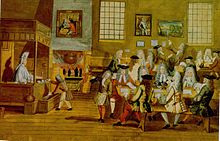
The 18th century was prosperous as entrepreneurs extended the range of their businesses around the globe. By the 1720s Britain was one of the most prosperous countries in the world, Daniel Defoe boasted:
- we are the most "diligent nation in the world. Vast trade, rich manufactures, mighty wealth, universal correspondence, and happy success have been constant companions of England, and given us the title of an industrious people."[114]
As an island there was little incentive for gaining new territory. In the Tudor and Stuart periods the main foreign policy goal (besides protecting the homeland from invasion) was the building a worldwide trading network for its merchants, manufacturers, shippers and financiers. This required a hegemonic
The government supported the private sector by incorporating numerous privately financed London-based companies for establishing trading posts and opening import-export businesses across the world. Each was given a monopoly of trade to the specified geographical region.[118] The first enterprise was the Muscovy Company set up in 1555 to trade with Russia. Other prominent enterprises included he East India Company (1599), and the Hudson's Bay Company (1670) in Canada. The Company of Royal Adventurers Trading to Africa had been set up in 1662 to trade in gold, ivory and slaves in Africa; it was reestablished as the Royal African Company in 1672 and focused on the slave trade. Other powers set up similar monopolies on a much smaller scale; only the Netherlands emphasised trade as much as England.[119]
Wool trade
Woolen cloth was the chief export and most important employer after agriculture. The golden era of the Wiltshire woolen industry was in the reign of Henry VIII. In the medieval period, raw wool had been exported, but now England had an industry, based on its 11 million sheep. London and towns purchased wool from dealers, and send it to rural households where family labour turned it into cloth. They washed the wool, carded it and spun it into thread, which was then turned into cloth on a loom. Export merchants, known as Merchant Adventurers, exported woolens into the Netherlands and Germany, as well as other lands. The arrival of Huguenots from France brought in new skills that expanded the industry.[120][121][122]
Government intervention proved a disaster in the early 17th century. A new company convinced Parliament to transfer to them the monopoly held by the old, well-established Company of Merchant Adventurers. Arguing that the export of unfinished cloth was much less profitable than the export of the finished product, the new company got Parliament to ban the export of unfinished cloth. There was massive dislocation marketplace, as large unsold quantities built up, prices fell, and unemployment rose. Worst of all, the Dutch retaliated and refused to import any finished cloth from England. Exports fell by a third. Quickly the ban was lifted, and the Merchant Adventurers got its monopoly back. However, the trade losses became permanent.[123][124]
Foreign policy
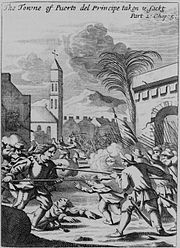
Stuart England was primarily consumed with internal affairs.
Lord Buckingham in the 1620s wanted an alliance with Spain.[128] Buckingham took Charles with him to Spain to woo the Infanta in 1623. However, Spain's terms were that James must drop Britain's anti-Catholic intolerance or there would be no marriage. Buckingham and Charles were humiliated and Buckingham became the leader of the widespread British demand for a war against Spain. Meanwhile, the Protestant princes looked to Britain, since it was the strongest of all the Protestant countries, to provide them with military support for their cause. James' son-in-law and daughter became king and queen of Bohemia, an event which outraged Vienna. The Thirty Years' War began, as the Habsburg Emperor ousted the new king and queen of the Kingdom of Bohemia, and massacred their followers. The Catholic Duchy of Bavaria then invaded the Electoral Palatinate, and James's son-in-law begged for James's military intervention. James finally realised that his policies had backfired and refused these pleas. He successfully kept Britain out of the European-wide war that proved so heavily devastating for three decades. James's backup plan was to marry his son Charles to a French Catholic princess, who would bring a handsome dowry. Parliament and the British people were strongly opposed to any Catholic marriage, were demanding immediate war with Spain, and strongly favoured the Protestant cause in Europe. James had alienated both elite and popular opinion in Britain, and Parliament was cutting back its financing. Historians credit James for pulling back from a major war at the last minute, and keeping Britain in peace.[129]
Frederick's election as King of Bohemia in 1619 deepened the Thirty Years' War—a conflagration that destroyed millions of lives in central Europe, but only barely touched Britain. The intense hatred and rivalry of Catholic versus Protestant princes was the main cause. King James' determination to avoid involvement in the continental conflict, even during the "war fever" of 1623, was one of the most significant, and most positive, aspects of his reign.[130]
During 1600–1650 the kings made repeated efforts to colonise Guiana in South America. They all failed and the lands (Suriname) were ceded to the Dutch Republic in 1667.[131][132]
Anglo-Dutch Wars

The Anglo-Dutch Wars were a series of three wars which took place between the English and the Dutch from 1652 to 1674. The causes included political disputes and increasing competition from merchant shipping. Religion was not a factor, since both sides were Protestant.[133] The British in the First Anglo-Dutch War (1652–54) had the naval advantage with larger numbers of more powerful "ships of the line" which were well suited to the naval tactics of the era. The British also captured numerous Dutch merchant ships.
In the Second Anglo-Dutch War (1665–67) Dutch naval victories followed. This second war cost London ten times more than it had planned on, and the king sued for peace in 1667 with the Treaty of Breda. It ended the fights over "mercantilism" (that is, the use of force to protect and expand national trade, industry, and shipping.) Meanwhile, the French were building up fleets that threatened both the Netherlands and Great Britain.
In the Third Anglo-Dutch War (1672–74), the British counted on a new alliance with France but the outnumbered Dutch outsailed both of them, and King Charles II ran short of money and political support. The Dutch gained domination of sea trading routes until 1713. The British gained the thriving colony of New Netherland, which was renamed as the Province of New York.[134][135]
Timeline
The Stuart period began in 1603 with the death of
Monarchs
The House of Stuart produced six monarchs who ruled during this period.
-
Charles II
(1660–1685) -
James II
(1685–1688) -
William III
(1689–1702) -
Mary II
(1689–1694) -
Anne
(1702–1714)
Historical gallery
-
St. James's Day Battle
References
- ^ For in-depth coverage, start with Lawrence Stone, The crisis of the aristocracy: 1558–1641 (abridged edition, 1967) pp 23–61.
- ^ Clayton Roberts, David Roberts, and Douglas R. Bisson, A History of England: Volume 1 (Prehistory to 1714) (4th ed. 2001) 1: 255, 351.
- ISBN 9781134858231.
- ^ Mark Kishlansky, A Monarchy Transformed, Britain 1630–1714 (1997) pp 19–20, 24–25.
- ISBN 9780313283918.
- ^ David Loades, ed. Reader's Guide to British History (2003) 2:1200–1206; J.H. Hexter, On History (1979) pp. 149–236
- ^ Robert Tombs, The English and Their History (2015) p 210.
- ^ Tyler Blethen and Curtis Wood, eds., Ulster and North America: transatlantic perspectives on the Scotch-Irish (1997).
- ^ David Coast, "Rumor and 'Common Fame': The Impeachment of the Duke of Buckingham and Public Opinion in Early Stuart England." Journal of British Studies 55.2 (2016): 241–267. online Archived 2017-08-23 at the Wayback Machine
- ISBN 9780300056884.
- ISBN 978-0521521338.
- ISBN 9780198217046.
- ISBN 9781351985420.
- ^ H. H. Leonard, "Distraint of Knighthood: The Last Phase, 1625–41." History 63.207 (1978): 23–37. online
- ^ M. D. Gordon, "The Collection of Ship-money in the Reign of Charles I." Transactions of the Royal Historical Society 4 (1910): 141–162. online
- ^ Coward, Stuart Age pp 152–55.
- ^ Pauline Gregg, King Charles I (1981), pp 324–26.
- ^ Conrad Russell, "Why Did Charles I Call the Long Parliament?." History 69.227 (1984): 375–383. online
- ^ Paul Christianson, "The Peers, the People, and Parliamentary Management in the First Six Months of the Long Parliament." Journal of Modern History 49.4 (1977): 575–599. online
- ^ Peter Gaunt, The English Civil War: A Military History (2014) pp 223–29.
- ^ Useful textbooks include Clayton Roberts, F. David Roberts, and Douglas Bisson, A History of England, Volume 1: Prehistory to 1714 (5th ed. 2016) ch 14; Michael Lynch, The interregnum: 1649–60 (1994); and Angela Anderson, The civil wars 1640-9 (1995).
- ^ J.S. Morrill, Oliver Cromwell and the English revolution (1990).
- ^ Nicole Greenspan, Selling Cromwell's Wars: Media, Empire and Godly Warfare, 1650–1658 (2016).
- ^ Blair Worden, The Rump Parliament 1648–53 (1977).
- ^ C.H. Midgley, "Political thinking and the creation of the Assembly of 1653." The Seventeenth Century 31.1 (2016): 37–56.
- ^ Austin Woolrych, Commonwealth to protectorate (1982).
- ^ Christopher Durston, "The Fall of Cromwell's Major-Generals," English Historical Review (1998) 113#450: 18–37. online.
- ^ Nathan Osterman, "The Controversy over the Proposed Readmission of the Jews to England (1655)." Jewish Social Studies (1941): 301–328 online.
- ^ R.C. Richardson, The debate on the English Revolution (Manchester UP, 1998) pp 65–97.
- ^ Blair Worden, "History's Heroic Age" History Today (2012) 62#4.
- ^ Richardson, The debate on the English Revolution (1998) pp 98–132.
- ^ Hugh Trevor-Roper, "Country-House Radicals 1590–1660" History Today (1953) 3#7 online Archived 2017-09-03 at the Wayback Machine
- ^ Richardson, The debate on the English Revolution (1998) pp 169–72.
- ^ Richardson, The debate on the English Revolution (1998) pp 133–49.
- ^ Barry Coward and Peter Gaunt, The Stuart Age: England, 1603–1714 (5th ed. 2017) pp 4–5 available at Amazon.
- ^ Richardson, The debate on the English Revolution (1998) pp 150–94.
- ^ David Ogg, England in the Reigns of James II and William III (1955) pp 195–221.
- ^ Bucholz and Key, Early Modern England, pp 265–66.
- ^ Ronald Hutton, Charles the Second, King of England, Scotland, and Ireland (Oxford UP, 1989) pp 133 – 214
- ^ J.G.A. Pocock, The Machiavellian moment: Florentine political thought and the Atlantic republican tradition (1975) pp 406–13.
- ^ Hutton, pp. 136, 141.
- ^ Hutton, pp 249–54.
- ^ Hutton, pp 134–35.
- ^ Tim Harris, Restoration: Charles II and his Kingdom 1660–1685 (2003), pp 43–51.
- ^ Francis, Richard. Judge Sewall's Apology. p. 41
- ^ Harris, p 53
- ^ J.P. Kenyon, Stuart England (1985) pp 195–213.
- ^ Correlli Barnett, Britain and her army, 1509–1970: a military, political and social survey (1970) pp 90–98, 110–25.
- ^ Harris, p 46
- ^ David G. Chandler, ed., The Oxford history of the British army (1996) pp 24–45.
- ^ Lord Macaulay The History of England from the accession of James the Second (C.H. Firth ed. 1913) 1:136-38
- ^ Chandler, ed., The Oxford history of the British army (1996) pp 46–57.
- ^ Steven Pincus, 1688: The First Modern Revolution (2011)
- ^ Steven C. A. Pincus, England's Glorious Revolution 1688–1689: A Brief History with Documents (2005)
- ^ E.N. Williams, ed., The Eighteenth-century Constitution 1688–1815 (1960) pp 1–66.
- ^ David Ogg, England in the Reigns of James II and William III (1955) pp 231–33.
- ^ Wout Troost, William III, The Stadholder-king: A Political Biography (2005) p 219.
- ^ Ogg, England in the Reigns of James II and William III (1955) pp 241–45.
- ^ Troost, William III pp 212–214
- ^ Julian Hoppit, A land of liberty?: England 1689–1727 (2000), pp 13–50.
- ^ George Clark, The Later Stuarts, 1660–1714 (2nd ed. 1956) pp 148–53.
- ^ Clayton Roberts et al., A History of England: volume I Prehistory to 1714 (5th ed. 2013) pp 245–48.
- ^ Mark A. Thomson, "Louis XIV and William III, 1689–1697." English Historical Review 76.298 (1961): 37–58. online Archived 2018-09-23 at the Wayback Machine
- ^ Clark, The Later Stuarts, 1660–1714 (1956) pp 160–74.
- ^ For the European context, see J.S. Bromley, ed. The New Cambridge Modern History, VI: The Rise of Great Britain and Russia, 1688–1725 (1970) pp 154–192, 223–67, 284–90, 381–415, 741–54.
- ^ John Brewer, The sinews of power: War, money, and the English state, 1688–1783 (1989) p 133.
- ^ Clark, The Later Stuarts, 1660–1714 (1956) pp 174–79.
- ^ David Onnekink, "'Mynheer Benting now rules over us': the 1st Earl of Portland and the Re-emergence of the English Favourite, 1689–99." English Historical Review 121.492 (2006): 693–713. online Archived 2018-08-31 at the Wayback Machine
- ^ For summaries of foreign policy see J.R. Jones, Country and Court: England, 1658–1714 (1979), pp 279–90; Geoffrey Holmes, The Making of a Great Power: Late Stuart and Early Georgian Britain, 1660–1722 (1993), pp 243–50, 434–39; Hoppit, A Land of Liberty?: England 1689–1727 (2002), pp 89–166; and for greater detail, Stephen B. Baxter. William III and the Defense of European Liberty, 1650–1702 (1966), pp 288–401.
- ISBN 9780837181615.
- ^ George Clark, The Later Stuarts 1660–1714. (2nd ed. 1955) pp 200–262.
- ^ Barry Coward and Peter Gaunt, The Stuart Age (5th ed. 2017) ch 13.
- ^ Coward and Gaunt, The Stuart Age pp 439–45.
- ^ Edward Gregg, Queen Anne (Yale UP, 2001) pp viii–ix
- doi:10.1093/ref:odnb/560. (Subscription or UK public library membershiprequired.)
- ^ James Anderson Winn, Queen Anne: Patroness of Arts (2014).
- ^ Joseph Hone, "Isaac Newton and the Medals for Queen Anne." Huntington Library Quarterly 79#1 (2016): 119–148. Online Archived 2018-11-20 at the Wayback Machine
- ^ T.M. Devine, The Scottish Nation: A History, 1700–2000 (1999) pp 1–30.
- ^ Karin Bowie, Scottish Public Opinion and the Anglo-Scottish Union, 1699–1707 (2007).
- ^ Devine, The Scottish Nation: A History, 1700–2000 (1999) pp 31–48.
- ^ G.N. Clark, The Later Stuarts, 1660–1714 (2nd ed. 1956) pp 290–93.
- ISBN 9781471137518.
- ^ E.A. Wrigley and R.S. Schofield, The population history of England 1541–1871 (1981) p 528
- ^ J.A. Sharpe, Early modern England: a social history 1550–1760 (1997) pp 36–42.
- ^ John Clapham, A concise economic history of Britain: From the earliest Times to 1750 (1949), pp 188–89.
- ^ William Monter, "Re-contextualizing British witchcraft." Journal of Interdisciplinary History 35.1 (2004): 105–111. online
- ^ Keith Thomas, Religion and the Decline of Magic (1971).
- ^ Jonathan Barry, "Introduction: Keith Thomas and the problem of witchcraft" in Jonathan Barry et al. eds., Witchcraft in early modern Europe: Studies in Culture and Belief (1996) pp. 1–46
- ^ Alan Macfarlane, Witchcraft in Tudor and Stuart England: A Regional and Comparative Study (1970).
- ^ Clarke Garrett, ""Women and witches: Patterns of analysis." Signs 3#2 (1977): 461–470. JSTOR Archived 2017-03-18 at the Wayback Machine
- ^ Peter Elmer, Witchcraft, Witch-Hunting, and Politics in Early Modern England (2016) ch 5.
- ^ Andrew Sneddon, "Witchcraft belief and trials in early modern Ireland." Irish Economic and Social History 39.1 (2012): 1–25.
- ^ Brian P. Levack, Witch-hunting in Scotland: Law, Politics and Religion (2007) pp 1–2. online review
- ISBN 9781134531950.
- ^ Alexander Broadie, ed. The Scottish Enlightenment (1999) pp 10–14
- ^ Jackie Eales, "To booke and pen: Women, education and literacy in Tudor and Stuart England." Historian 119 (2013): 24:24–29.
- ^ Dorothy Gardiner, English Girlhood at School: A Study of Women's Education through twelve centuries (1929)
- ^ Peter Burke, "Popular culture in seventeenth-century London." The London Journal 3.2 (1977): 143–162. online
- ^ George Clark, The Later Stuarts, 1660–1714 (1956) p 369.
- ^ Lawrence E. Klein, "Coffeehouse Civility, 1660–1714: An Aspect of Post-Courtly Culture in England" Huntington Library Quarterly 59#1 (1996), pp. 30– 51. online Archived 2017-03-23 at the Wayback Machine
- ^ Brian Cowan, "What Was Masculine about the Public Sphere? Gender and the Coffeehouse Milieu in Post-Restoration England." History Workshop Journal. No. 51: 127–157. online
- ^ Mark Pendergrast, Uncommon Grounds: The History of Coffee and How It Transformed Our World (1999) p 13 online Archived 2017-08-24 at the Wayback Machine
- ^ Keith Suter, "The Rise and Fall of English Coffee Houses," Contemporary Review (Feb. 2005) 286#1669 online
- ^ Michael Hunter, Science and society in Restoration England (1981).
- ISSN 0031-2746.
- ^ E. Chaney, The Evolution of the Grand Tour, 2nd ed. (2000) and idem, Inigo Jones's "Roman Sketchbook", 2 vols (2006)
- ^ "Grand Tour". Oxford Reference. Retrieved 20 May 2022.
- ISBN 978-88-7760-019-6.
- ^ Boris Ford, ed., The Cambridge Cultural History of Britain: Volume 4, Seventeenth Century Britain (1992), pp 52–103, 276–307.
- ^ 'Charles II, 1666: An Act for rebuilding the City of London.', Statutes of the Realm: volume 5: 1628-80 (1819), pp. 603-12. URL: http://www.british-history.ac.uk/report.asp?compid=47390. Date accessed: 08 March 2007.
- ISBN 9780719040764.
- ^ Charles Phythian-Adams, Societies, Cultures and Kinship, 1580–1850: Cultural Provinces and English Local History (Leicester, 1996), pp. 9–23.
- ^ H.J. Dyos and D.H. Aldcroft, British transport: an economic survey from the seventeenth century to the twentieth (1969) pp 19–44, 99–102.
- ^ Julian Hoppit, A Land of Liberty?: England 1689–1727 (2000) p 344
- ^ Peter J. Bowden, The Wool Trade in Tudor and Stuart England (1962) online Archived 2017-09-05 at the Wayback Machine
- ^ D.C. Coleman, The economy of England, 1450–1750 (1977), pp 48–55, 130–45.
- ^ E. Lipson, The Economic History of England (1931) p 188-89.
- ^ Ann M. Carlos and Stephen Nicholas. "'Giants of an Earlier Capitalism': The Chartered Trading Companies as Modern Multinationals." Business History Review 62#3 (1988): 398–419. in JSTOR Archived 2018-09-23 at the Wayback Machine
- ^ Eric J. Evans, The forging of the modern state: early industrial Britain, 1783–1872 (1996) p 31.
- ^ G.D. Ramsay, The English woollen industry, 1500–1750 (1982).
- ^ E. Lipson, The Economic History of England: vol 2: The age of mercantilism (7th 1964) pp 10–92.
- ^ Peter J. Bowden, Wool Trade in Tudor and Stuart England (1962) online Archived 2017-09-05 at the Wayback Machine.
- ^ C.G.A. Clay, Economic Expansion and Social Change: England 1500–1700: Volume 2, Industry, Trade and Government (1984) pp 119–20.
- from the original on 21 July 2023. Retrieved 21 July 2023.
- ^ Roger Lockyer, James VI and I (1998) pp 138–58.
- ^ Malcolm Smuts, "The making of Rex Pacificus: James VI and I and the Problem of Peace in an Age of Religious War," in Daniel Fischlin and Mark Fortier, eds., Royal Subjects: Essays on the Writings of James VI and I (2002) pp 371–87
- ^ W. B. Patterson, "King James I and the Protestant cause in the crisis of 1618–22." Studies in Church History 18 (1982): 319–334.
- ^ Godfrey Davies, The Early Stuarts: 1603–1660 (1959), pp 47–67
- ^ Jonathan Scott, England's Troubles: 17th-century English Political Instability in European Context (Cambridge UP, 2000), pp 98–101
- ^ G.M.D. Howat, Stuart and Cromwellian Foreign Policy (1974) pp 17–42.
- ^ Joyce Lorimer, "The failure of the English Guiana ventures 1595–1667 and James I's foreign policy." Journal of Imperial and Commonwealth History 21#.1 (1993): 1–30.
- ^ Albert J. Loomie, Spain & the Early Stuarts, 1585–1655 (1996).
- ^ Steven C. A. Pincus, Protestantism and Patriotism: Ideologies and the Making of English Foreign Policy, 1650–1668 (1996)
- ^ James Rees Jones, The Anglo-Dutch wars of the seventeenth century (1996) online
- ^ Gijs Rommelse, "The role of mercantilism in Anglo‐Dutch political relations, 1650–74." Economic History Review 63#3 (2010): 591–611.
Further reading
- Braddick, Michael J. The Nerves of State: Taxation and the Financing of the English State, 1558-1714 (Manchester University Press, 1996).
- Bucholz, Robert, and Newton Key. Early Modern England 1485–1714: A Narrative History (2009); university textbook.
- Burke, Peter "Popular Culture in Seventeenth-century London." The London Journal 3.2 (1977): 143–162. online
- Campbell, Mildred. English Yeoman Under Elizabeth and the Early Stuarts (1942), rich coverage of rural life
- Clark, George, The Later Stuarts, 1660–1714 (Oxford History of England) (2nd ed. 1956), a wide-ranging standard scholarly survey.
- Coward, Barry, and Peter Gaunt. The Stuart Age: England, 1603–1714 (5th ed 2017) new introduction; a wide-ranging standard scholarly survey.
- Coward, Barry, ed. A Companion to Stuart Britain (2009) excerpt and text search; 24 advanced essays by scholars; emphasis on historiography; contents
- Davies, Godfrey. The Early Stuarts, 1603–1660 (Oxford History of England) (2nd ed. 1959), a wide-ranging standard scholarly survey.
- Fritze, Ronald H. and William B. Robison, eds. Historical Dictionary of Stuart England, 1603–1689 (1996), 630pp; 300 short essays by experts emphasis on politics, religion, and historiography excerpt
- Holmes, Geoffrey (1987). British Politics in the Age of Anne. A&C Black. p. 643pp. ISBN 9780907628743.
- Hoppit, Julian. A Land of Liberty?: England 1689–1727 (Oxford UP, 2000) (The New Oxford History of England), a wide-ranging standard scholarly survey.
- Kenyon, J.P. Stuart England (Penguin, 1985), survey
- Kishlansky, Mark A. A Monarchy Transformed: Britain, 1603–1714 (Penguin History of Britain) (1997), standard scholarly survey; excerpt and text search
- Kishlansky, Mark A. and John Morrill. "Charles I (1600–1649)", Oxford Dictionary of National Biography (2004; online edn, Oct 2008) accessed 22 Aug 2017 doi:10.1093/ref:odnb/5143
- Lipson, Ephraim. The Economic History of England: vol 2: The Age of Mercantilism (7th ed. 1964)
- Miller, John. The Stuarts (2004)
- Miller, John. The Restoration and the England of Charles II (2014).
- Morrill, John. Stuart Britain: A Very Short Introduction (2005) excerpt and text search; 100pp
- Morrill, John, ed. The Oxford illustrated History of Tudor & Stuart Britain (1996) online, a wide-ranging standard scholarly survey.
- Mulligan, William, and Brendan Simms, eds. The Primacy of Foreign Policy in British History, 1660–2000 (2011) pp 15–64.
- Murray, Catriona. Imaging Stuart Family Politics: Dynastic Crisis and Continuity (Routledge, 2017).
- Notestein, Wallace. English People on the Eve of Colonization, 1603–1630 (1954). scholarly study of occupations and roles
- O'Brien, Patrick K. "The Political Economy of British Taxation, 1660‐1815", in Economic History Review (1988) 41#1 pp: 1–32. in JSTOR
- Ogg, David. England in the Reign of Charles II (2 vol 1934), a wide-ranging standard scholarly survey.
- Ogg, David. England in the Reigns of James II and William III (1955), a wide-ranging standard scholarly survey.
- Pincus, Steve. 1688: The First Modern Revolution (2011)
- Pincus, Steven C. A. England's Glorious Revolution 1688–1689: A Brief History with Documents (2005)
- Roberts, Clayton and F. David Roberts. A History of England, Volume 1: Prehistory to 1714 (2nd ed. 2013), university textbook.
- Sharp, David. The Coming of the Civil War 1603–49 (2000), textbook
- Sharp, David. England in Crisis 1640–60 (2000), textbook
- Sharp, David. Oliver Cromwell (2003); textbook
- Sharpe, Kevin. The Personal Rule of Charles I (Yale UP, 1992).
- Sharpe, Kevin, and Peter Lake, eds. Culture and Politics in Early Stuart England (1993)
- Thurley, Simon. Palaces of Revolution: Life, Death and Art at the Stuart Court (2021)
- Traill, H. D. and J.S. Mann, eds. Social England; a record of the progress of the people in religion, laws, learning, arts, industry, commerce, science, literature and manners, from the earliest times to the present day (1903) short essays by experts; illustrated' 946pp. online
- Wilson, Charles. England's Apprenticeship, 1603–1763 (1967), comprehensive economic and business history.
- Woolrych, Austin. Britain in Revolution: 1625–1660 (2004), a wide-ranging standard scholarly survey.
- Wroughton, John. ed. The Routledge Companion to the Stuart Age, 1603–1714 (2006) excerpt and text search
Historiography
- Baxter, Steven B. "The Later Stuarts: 1660–1714," in Richard Schlatter, ed., Recent Views on British History: Essays on Historical Writing since 1966 (Rutgers UP, 1984), pp 141–66
- Braddick, Michael J., ed. The Oxford Handbook of the English Revolution (Oxford UP, 2015). 645pp 33 essays by experts on specialised topics; emphasis on historiography
- Burgess, Glenn. "On Revisionism: An Analysis of Early Stuart Historiography in the 1970s and 1980s." Historical Journal (1990) 33#3 pp: 609–27. online
- Cressy, David. "The Blindness of Charles I." Huntington Library Quarterly 78.4 (2015): 637–656. excerpt
- Harris, Tim. "Revisiting the Causes of the English Civil War." Huntington Library Quarterly 78.4 (2015): 615–635. excerpt
- Hirst, Derek. "Of Labels and Situations: Revisionisms and Early Stuart Studies." Huntington Library Quarterly 78.4 (2015): 595–614. excerpt
- Johnson, Richard R. "Politics Redefined: An Assessment of Recent Writings on the Late Stuart Period of English History, 1660 to 1714." William and Mary Quarterly (1978): 691–732. in JSTOR
- Lake, Peter. "From Revisionist to Royalist History; or, Was Charles I the First Whig Historian." Huntington Library Quarterly 78.4 (2015): 657–681. excerpt
- Morrill, John. "Revisionism's Wounded Legacies" Huntington Library Quarterly (2015) 78#4 pp. 577–594 online
- Monod, Paul Kleber. "A Restoration? 25 years of Jacobite studies." Literature Compass 10.4 (2013): 311–330.
- Richardson, R. C. The Debate on the English Revolution Revisited (1977)
- Russell, Conrad. “Parliamentary History in Perspective, 1604–1629,” History 61 (1976): 1–27. online
- Underdown, David. "New Ways and Old and Early Stuart History," in Richard Schlatter, ed., Recent Views on British History: Essays on Historical Writing since 1966 (Rutgers UP, 1984), pp 99–140
- Walcott, Robert. "The Later Stuarts (1660–1714): Significant Work of the Last Twenty Years (1939–1959)" American Historical Review 67#2 (1962) pp. 352–370 DOI: 10.2307/1843428 in JSTOR
- Zagora, Perez. "English History, 1558–1640: A Bibliographical Survey," in Elizabeth Chapin Furber, ed. Changing views on British history: essays on historical writing since 1939 (Harvard UP, 1966), pp 119–40
Primary sources
- Blitzer, Charles, ed. The Commonwealth Of England: Documents Of The English Civil Wars, The Commonwealth And Protectorate, 1641–1660 (2012).
- Browning, A. ed. English Historical Documents 1660–1714 (1953)
- Coward, Barry, and Peter Gaunt, eds. English Historical Documents, 1603–1660 (2011)
- Key, Newton, and Robert O. Bucholz, eds. Sources and Debates in English History, 1485–1714 (2009).
- Kenyon, J.P. ed. The Stuart Constitution, 1603–1688: Documents and Commentary (1986).
- Lindley, Keith, ed. The English Civil War and Revolution: A Sourcebook (Routledge, 2013). 201pp
- Stater, Victor, ed. The Political History of Tudor and Stuart England: A Sourcebook (Routledge, 2002)
- Williams, E.N., ed., The Eighteenth-century Constitution 1688–1815: Documents and Commentary (1960), 464pp.

